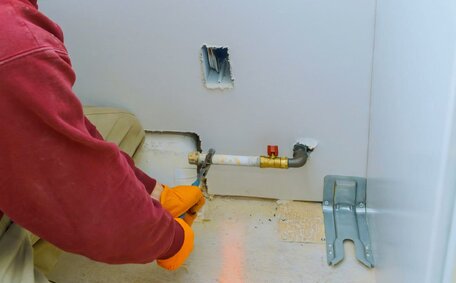Introduction to Plungers
Plungers are essential tools for unclogging drains and tackling minor household blockages.
Plungers offer a simple and cost-effective first step in clearing blocked drains, often eliminating the need for professional help. The key types include flange plungers for sinks and showers, and force cup plungers for toilets.
Wearing rubber gloves, align the plunger over the drain and employ a vertical pumping action to establish suction that clears debris such as food particles, grease, hair, and soap from the pipe walls.
Although plungers can resolve simple clogs, profound blockages might be located in deeper sections of the drainage, beyond their reach. Tree roots and dense clumps of grease or compacted wipes may necessitate the power of hydro jet drain cleaners, which can work in tandem with a plumber’s snake or pipe excavation executed by an expert technician.
Types of Plungers
Cup Plungers
Cup plungers, also known as sink plungers, come with a broad rubber cup on a handle, making them suitable for dislodging blockages in sinks and shower drains through a push-pull action. They are particularly effective in:
- Ensuring a clear and safe pathway within bathroom drains
- Basins
- Floor drains
- Laundry tubs
Toilet Plungers
Toilet plungers, essential for fixing clogged toilets, feature a tapered rubber cup that forms a snug seal inside the toilet bowl and trapways. Intense suction is created by pushing and pulling the plunger to clear the clog from the drain. Toilet plungers should only be used for:
- Toilet bowls
- Toilet trapways
Accordion Plungers
Accordion plungers, equipped with collapsible rubber cups and sometimes a hand crank, play a pivotal role in tackling clogged drains. They expand over the drain and can reach further down the pipe to clear blockages with a plunging action. Effective for:
- Kitchen sinks, bathroom basins, and laundry drains
- Pipes and fixtures with smaller diameters
- Partially clogged drains
How to Use a Plunger to Unblock a Drain
Proper use of a plunger, as explained in our guide, can swiftly transform it into an effective DIY solution for minor drain obstructions. The key steps to clear blockages effectively include:
- To expedite movement in the case of standing water in your sink, If the water is draining slowly, half-fill the basin with hot water. If it’s still blocked, fill the basin with full water and Ensure the liquid is poured down drain effectively.
- Place the plunger firmly over the drain to ensure a tight seal for maximum plunging effectiveness. For dealing with a tangled sink drain, youll need a sink plunger inserted firmly into the pipe. For your toilet, use a flanged force-cup plunger designed to seal toilet bowls.
- Thrust energetically up and down, introducing air into your pipe to generate pressure until the clog is dislodged and the pathway clears. Use quick, forceful strokes rather than pushing down slowly.
- Continue the motion for a few minutes, Then try pouring hot water to check the drain and learn how clear the flow indicate if the clog is dislodged and debris cleared. When water starts draining from a clear blocked drain, Remove plunger and let drain and send some hot water down to clear any residue.
Maintain a complete seal over the drain to maximise the plunger’s pressure.
Should the water remain unmoved after using the above methods, drain cleaners can be considered before intense plunging for 5-10 minutes, or it might be time to call a plumber. For stubborn blockages, consider chemical drain cleaners or mechanical snakes, but a skilled plumber may use drain snakes or a power auger for severe clogs.
When a Plunger Fails
Sometimes a plunger just isn’t enough to get the job done. If successful plunging and other methods don’t resolve a clogged drain after several minutes, consider using a drain auger from a hardware store before seeking professional help.
Alternative Drain Unblocking Methods
If a plunger fails, you can try these DIY drain unclogging techniques:
- Vinegar and Baking Soda - Tip a mixture of baking soda and vinegar down the drain to create a fizzing reaction that can help dismantle the clog.
- Wire Hanger - Straighten a wire hanger and use it to extract hair and debris, clearing obstructions from the drain.
- Drain Snake - Carefully manoeuvre the drain snake a few feet of cable down the pipework, gripping and dislodging the blockage with precision.
Calling in the Experts
If you are in a bind, youll find yourself pondering, 'what do I do now?' because DIY methods haven’t resolved the clog, consider contacting a plumber to avoid actions that could damage pipes. Your plumber might employ a powerful auger plumbers snake or closet auger for relentless clogs, engaging high pressure jetting or excavation methods. Drummoyne Plumbing has the advanced tools and expertise to clear even severe blockages and get your drains flowing freely again.
For expert advice on drain unblocking or reliable services in the area, email or call our team today.
Preventing Future Clogs
Taking straightforward measures can help prevent the frustration of blocked drains:
Use Drain Strainers
Regularly pour baking soda and vinegar into your sink, followed by hot water, to prevent worsening clogs. Keeping the area under the sink clean minimises the accumulation of debris that might create blockages. Employ fine mesh strainers that can get capture finer debris, and rinse water into with cold water to safeguard your drains.
Monitor What Goes Down Drains
Avoid pouring fats, oils, and grease down the drain; instead, let them solidify and then discard them in the rubbish bin. Dispose of non-degradable items such as wipes, sanitary products, and washing powder packets in the bin, not the drain.
Keep Drains Clear
Flush your sink regularly with white vinegar and boiling water, allowing the mixture to break down potential clogs over half an hour.
Professional Maintenance
Arrange routine drain inspections and cleanings every 6-12 months that employ high-pressure water jetting and strong augers.
Email or call our team to book an appointment.






